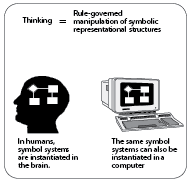
A full-sized version of the original can be ordered here.
The questions addressed on
Map 3 – Can Physical Symbol Systems Think? are:
- Does thinking require a body?
- Is the relation between hardware and software similar to that between human brains and minds?
- Can physical symbol systems learn as humans do?
- Can the elements of thinking be represented in discrete symbolic form?
- Can symbolic representations account for human thinking?
- Does the situated action paradigm show that computers can't think?
- Can physical symbol systems think dialectically?
- Can a symbolic knowledge base represent human understanding?
- Do humans use rules as physical symbol systems do?
- Does mental processing rely on heuristic search?
- Do physical symbol systems play chess as humans do?
- Other physical symbol systems arguments

Thinking in a physical symbol system is a formal computational process characterized by:
- rule governed symbol manipulation
- drawing of inferences from large knowledge bases
- heuristic search of data structures
- operations on representational structures
- planning and goal-directed activity.
The symbolic processes that constitute thinking are formal in that they are independent of any particular physical instantiation. In humans, thinking is instantiated in the neurons of the brain: in computers, thinking is realized in silicon circuits.
Newell & Simon note (p.16): "A physical symbol system has the necessary and sufficient means for general intelligent action. By 'necessary' we mean that any system that exhibits general intelligence will prove upon analysis to be a physical symbol system. By 'sufficient' we mean that any physical symbol system of sufficient size can be organized further to exhibit general intelligence."
Allen Newell & Herbert Simon 1976.
Notes:
1) This is a condensed interpretation of a field that is itself controversial. The summary is presented here in this form to emphasize those aspects of the field most relevant to this map.
2) The physical symbol system and functionalism are closely related, with the former proposing an architecture for simulating & studying intelligence, and the latter constituting a philosophical position that is used to justify this architecture. For more on functionalism, which was developed in part as a response to behaviorism (see Map 2), see Map 6.
Postulates of the Physical Symbol Systems Hypothesis
1) The physical symbol system:
- is physical (that is, made up of some physical matter)
- is a specific kind of system (that is ,a set of components functioning through time in some definable manner) that manipulates instances of symbols.
2) Symbols can be thought of as elements that are connected and governed by a set of relations called a symbol structure. The physical instances of the elements (or tokens) are manipulated in the system.
3) An information process is any process that has symbol structures for at least one of its inputs or outputs.
4) An information processing system is a physical symbol system that consists of information processes.
5) Symbol structures are classified into
6) The program is a symbol structure that designates the sequence of information processes (including inputs and outputs) that will be executed by the elementary information processes of the processor.
7) Memory is a component of an information processing system that stores symbol structures.
8) Elementary information processes are transformations the processor can perform upon symbol structures (e.g. comparing and determining equality, deleting, placing in memory, retrieving from memory, etc).
9) A processor is a component of an information processing system that consists of:
- a fixed set of elementary information processes,
- a short-term memory that stores the input and output symbol structures of the elementary information processes, and
- an interpreter that determines the sequence of elementary information processes to be executed as a function of the symbol structures in short-term memory.
10) The external environment of the system consists of "readable" stimuli. Reading consists of creating internal symbol structures in memory that designate external stimuli. Writing is the operation of emitting the responses to the external environment that are commanded by the internal symbol structures.

Adapted from Newell and Simon (1972, Chapter 2).
Proponents include Jerry Fodor, Allen Newell, Herbert Simon, John McCarthy, Zenon Pylyshyn, early Marvin Minsky, Doug Lenat, Edward Feigenbaum, and Pat Hayes.